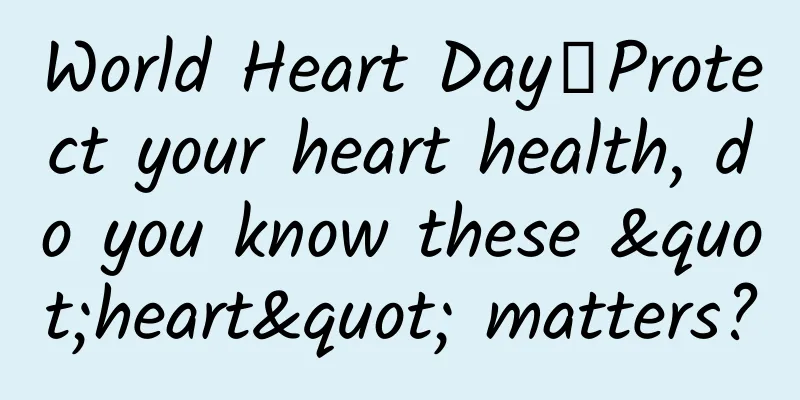World Heart Day丨Protect your heart health, do you know these "heart" matters?

|
World Heart Day was established by the World Heart Federation in 1999 and is held annually. The first World Heart Day was held on September 24, 2000, and the last Sunday of September has been World Heart Day since then. Since 2011, it has been changed to September 29. Its purpose is to promote knowledge about heart health worldwide and let the public realize that life requires a healthy heart. Changde City Fourth People's Hospital reminds that heart disease is the number one killer threatening human life and health. In order to remind people to pay attention, the World Heart Federation has established an annual "World Heart Day". 1.What is the function of the heart? The heart plays an important role in our daily activities. Specifically, the heart has the following functions: 1. The blood circulation of the human body is realized by the action of the heart "pump". The heart keeps beating, which transports blood to all parts of the body. The amount and speed of blood released by the heart change with the changes of human body functions. 2. The heart promotes blood flow, and the flowing blood transports oxygen and various nutrients (water, inorganic salts, glucose, protein, various water-soluble substances, vitamins, etc.) to various cells in the body, enabling them to function normally. 3. The heart is not only a power organ but also an endocrine organ. It also has endocrine functions. It can synthesize substances needed by the human body, make blood vessels unobstructed and relaxed, thereby promoting drainage from the kidneys. Like the pancreas, the heart can also secrete some substances to regulate the body. 2. What is a heart attack? Sudden spasms or blockages can lead to long-term myocardial ischemia and hypoxia, which can cause heart dysfunction. Long-term coronary stenosis can cause myocardial cell death, leading to angina pectoris and even myocardial infarction. During a heart attack, patients may experience symptoms such as oppressive pain behind the sternum, dyspnea, nausea and vomiting. Some patients may also have psychological reactions of anxiety and fear. 3. What does a heart attack feel like? The five main symptoms of a heart attack are pain, dizziness, abnormal complexion, difficulty breathing, and arrhythmia: 1. Pain: When a heart attack occurs, there will be a compressive pain in the chest, and this pain may extend along one or both sides of the arm to the neck, back, elbows, teeth and upper and lower jaws. 2. Dizziness: When a heart attack occurs, the heart cannot effectively pump blood throughout the body, which can cause hypoxia. The patient may experience dizziness and confusion, and in severe cases, fainting, convulsions, and other phenomena. 3. Abnormal complexion: During a heart attack, the person's face may appear pale or blue. 4. Difficulty breathing: During a heart attack, the patient may experience symptoms such as palpitations, shortness of breath, chest tightness, and difficulty breathing. 5. Arrhythmia: If you have a heart attack, it may cause arrhythmia. You may experience a faster or irregular heartbeat. 4. How to prevent heart disease? 1. Diet Adhere to a low-fat, low-cholesterol, and low-salt diet. For example, braised pork, fried dough sticks, pickles, etc. are not recommended for long-term use. Eat more fresh fruits, vegetables, and whole grains. 2. Living habits Ensuring adequate sleep, avoiding long-term fatigue, anxiety caused by staying up late and excessive psychological stress, and engaging in aerobic exercise are all very important for the prevention of heart disease. 3. Control risk factors Actively control the risk factors for heart disease, such as lowering blood pressure, lowering blood sugar and blood lipids, which are risk factors, and controlling them within normal range. 5. How to care for heart disease? 1. Standardized medication: Follow the doctor's instructions to take medications in a standardized manner. Do not stop taking medications, change medications, or increase or decrease the dosage without authorization. 2. Regular follow-up visits: Go to the hospital for regular follow-up visits to monitor the recovery of various indicators; 3. Improve your diet: Maintain a balanced diet and eat a proper amount of whole grains, beans, etc. Eat less greasy and high-sugar foods, limit sodium intake, avoid irritating foods, avoid drinking strong alcohol, overeating, and cold or hot stimulation; 4. Exercise appropriately: After the condition improves, patients can exercise for 30 minutes every day, such as walking and yoga, but avoid strenuous exercise and heavy physical work. Patients with unstable angina or severe hypertension or heart failure should not exercise. 5. Emotional management: Avoid fits of rage, anxiety, excessive sadness, etc. Hunan Medical Chat Special Author: Huang Manni, Department of Cardiovascular Medicine, Changde Fourth People's Hospital Follow @湖南医聊 to get more health science information! (Edited by YH) |
<<: Let yourself go and deal with Hashimoto's thyroiditis easily
>>: Can I still eat bread that has sodium diacetate added to it?
Recommend
Red pimples on vulva
The vulva is a female external reproductive organ...
What is the reason for low fertility?
Progesterone is an important hormone in the femal...
How to have high-quality sleep? Do these things and you will have sweet dreams!
It is very important to form good sleeping habits...
What are the symptoms of infertility after abortion?
Abortion is very harmful to the body, especially ...
How to prevent urethral pain in women?
The female urethra is shorter because there is no...
Can I eat grapes during confinement? Pregnant women must know
Grapes are highly sought after because of their m...
Pelvic effusion 1.5
Pelvic effusion is a term that many women are not...
Average height of girls in the country
The average height and weight data of men and wom...
What is the reason for tea-colored urine?
Under normal circumstances, urine should appear l...
Can Lancome Aurora Water be used on sensitive skin? What skin and age is Lancome Aurora Water suitable for?
Lancome Aurora Water is for combination skin and ...
AI diagnoses Alzheimer's disease: There is still a long way to go to replace doctors
Author: Huang Yanhong Duan Yuechu With the rapid ...
17 weeks pregnant lower abdominal pain
Nowadays, many young people have found their othe...
Vitamin B2 is so powerful
Vitamin B2 cannot be stored in the human body, bu...
What is regulating menstrual disorders?
Female friends generally encounter menstrual dysf...
Is it better to install a door sill when renovating a house? What is the function of installing a door sill in a house?
We all know that house decoration is a very compl...









